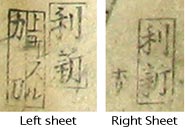Background
The Sôsen-ji (Sôzen Temple: 崇禅寺) in Higashi-Osaka was dedicated to the soul of Ashikaga Yoshinori (足利義教 1391-1441), the sixth shôgun of the Ashikaga shogunate, who was murdered in 1441 by Mitsusuke Akamatsu (赤松 満祐 1381-1441), unleashing political chaos that led to a peasant uprising known as the Kakitsu no tokusei ikki ("Kakitsu Uprising": 嘉吉の徳政一揆), named after the era Kakitsu (嘉吉 Feb. 1441 – Feb. 1444). Yoshinori was an oppressive and dictatorial ruler who infuriated the Akamatsu clan by planning to award three of the provinces they controlled to a young Ashikaga heir. The Akamatsu arranged for his assassination during a Nô performance at an Akamatsu residence.
The riding grounds of Sôzen-ji were in a pine grove that extended from the temple's west gate to Sôja-jinja shrine. The grounds were used for training in horseback riding. Katakiuchi sôzenji baba (Revenge at the riding ground of Sôsen Temple: 敵討崇禅寺馬場) was based on an actual incident that took place at the site of the Sôsen Temple in 1715. In the theatrical adaptation, Enjô Jizaemon (遠城治左衛門) and Ando Kihachirô (安藤喜八郎) seek revenge upon Ikuta Denpachirô (生田伝八郎), who had murdered their brother. They confront him at the Sôzen-ji riding ground, but are killed by Ikuta Denhachirô (who had enlisted the aid of many allies).
Katakiuchi sôzenji baba was very popular with kabuki audiences and, among commoners, the grounds became strongly associated with the drama. However, the riding grounds have since been converted into land for housing, and the torii (Shinto shrine archway or gate with two cross beams at the top: 鳥居) has been moved elsewhere.
Design

In ukiyo-e, a favorite scene, as in Hokushû's print, shows Fukumaru and Tomimaru brandishing cherry branches by the temple steps. Each wears his hair in a style called chigo-mage ("page's chignon"). The cherry branches, might correspond to the poems in the roundels, which speak about the viewing of cherry blossoms, but with sentiments colored by a feeling of sadness at parting and of nature withering.
The two small characters alongside Toshin's seal on the right sheet read hori ("cutter"), but without a name. The seal near Toshin's seal on the left sheet reads Kamichô suru ("printed by Kamichô") and Ka hori ("cut by Ka[suke]"), making this another collaboration between Hokushû and the celebrated block cutter.
References: KNZ, no. 250